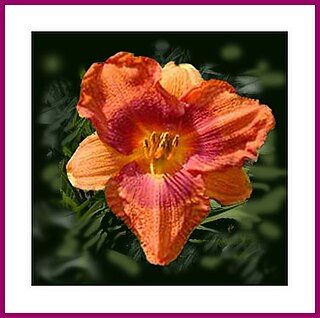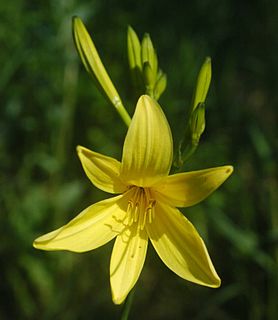
The Western Kentucky Botanical Garden (WKBG) is a botanical garden in Owensboro, Kentucky. The Garden contains several themed gardens including a large collection of daylilies with an American Hemerocallis Society-recognized display garden. Other gardens include a large herb garden, a rose garden, an English cottage garden, a Kentucky symbol quilt garden, a Japanese memorial garden, an ericaceous garden, the Moonlite Children’s garden, the University of Kentucky Extension display garden, and a Western Kentucky University experimental garden.. The Garden also includes several ponds and many works of public art including insect and wind sculptures.
Paul Arnold Fryxell (2 February 1927, Moline, Illinois – July 11, 2011 Claremont, California was an American botanist.

Hemerocallis 'Duke of Durham' is a hybrid daylily introduced in 1977 by Dr. Robert Day Elliott, Jr.
The Victoria Medal of Honour (VMH) is awarded to British horticulturists resident in the United Kingdom whom the Royal Horticultural Society Council considers deserving of special honour by the Society
Sydney Percy-Lancaster, F.L.S., F.R.H.S., M.R.A.S. was born on 19 July 1886 at Meerut, India. His father, Percy Lancaster, was a banker and a talented amateur gardener, who went on to become the Secretary of the Agri Horticultural Society of India in Calcutta, India.
Robert Harold Compton was a South African botanist. The Compton Herbarium at Kirstenbosch National Botanical Garden, which he founded in Cape Town in 1939, was named in his honour.
Ulysses Prentiss Hedrick (1870–1951) was an American botanist and horticulturist.
Siloam daylilies are cultivars of daylilies registered with the American Hemerocallis Society by Pauline Henry of Siloam Springs, Arkansas. Mrs. Henry registered over 450 daylilies during her lifetime. Most of her daylilies were given a name beginning with the word "Siloam", hence "Siloam Daylilies".
Alfred Byrd Graf was a German-American botanist who traveled the world in search of obscure plant species, discovering more than 100 previously undocumented varieties. He photographed and documented his findings in a number of richly illustrated books he wrote on the subject.
William Lacy Brown was an American geneticist notable for breeding programs in maize, sorghum, soybeans and wheat. He was president, chairman and chief executive of Pioneer Hi-Bred International. He was also a director of the Rockefeller Foundation's advisory committee on maize. Brown was elected to the National Academies of Science. The National Academies Press said that Brown "made significant and lasting contributions to increasing and stabilizing food production worldwide".

Theodore Luqueer Mead was an American naturalist, entomologist and horticulturist. As an entomologist he discovered more than 20 new species of North American butterflies and introduced the Florissant Fossil Beds in Colorado to the wider scientific world. As a horticulturist, he is best known for his pioneering work on the growing and cross-breeding of orchids, and the creation of new forms of caladium, bromeliad, crinum, amaryllis and hemerocallis (daylily). In addition he introduced many new semi-tropical plants, particularly palm varieties, into North America. Recently a comprehensive historical biography of his life and times has been published.
Stout is a surname. Notable people with the surname include:
George Yeld (1845–1938) was a schoolmaster, climber, explorer and hybridiser of daylilies and irises. He was a member of the Alpine Club and editor of the Alpine Journal. Much of his climbing and exploration was conducted with volcanologist Tempest Anderson and he published reports of his exploits and produced introductory books on Latin for scholars. Yeld received the Victoria Medal of Honour from the Royal Horticultural Society in 1925.
James Marion Shull (1872–1948) was an American botanist known for his iris cultivars and botanical illustrations.
Mildred Esther Mathias (1906-1995) was an American botanist born in Sappington, Missouri on September 19, 1906.
Dr Harold Roy Fletcher FRSE (1907-1978) was an English botanist and horticulturalist. He was Regius Keeper of the Royal Botanic Garden Edinburgh from 1956 to 1970 and Her Majesty's Botanist 1966 to 1978. As an author he is known as H. R. Fletcher.







